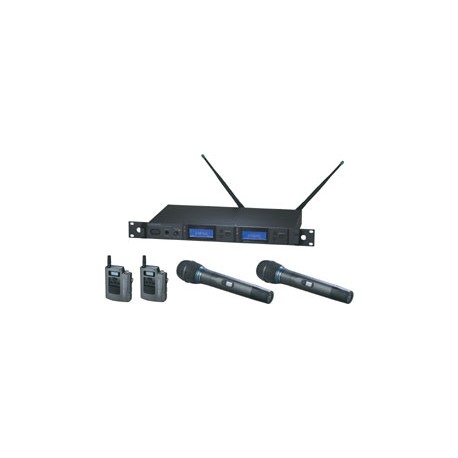
Wireless microphones project a speaker’s voice while allowing them to move freely about the room during a presentation. There are a variety of wireless microphone systems and components on the market, but every system consists of these three parts:
- Microphone
There are three common types of wireless microphones, each with a specific purpose.
- Handheld
While this is the simplest wireless microphone, it also produces the highest quality of audio of all the options. This is due to the size of the diaphragm that it has. It is easily passed around for question and answer settings or interviewing.
- Lavalier
For speakers who need both hands free during a presentation, the lavalier microphone is their best option. It can be attached in many ways, reducing its visibility. The mobility and use of both hands makes up for the slight reduction in sound quality. This type of microphone connects to the transmitter via a thin cable.
- Headset
For those who need complete freedom for movement, such as performers and fitness instructors, headset microphones are a common choice. The microphone is positioned close to the mouth and away from clothing so it doesn’t pick up any movement sounds. The transmitter for this microphone is in the ear clip, which is connected to the microphone by a thin, pliable wire.
- Transmitter
The transmitter sends the sound from the microphone to the wireless receiver at the mixing console. There are two types: handheld and bodypack. Handheld microphones have the transmitter built in to the microphone itself.
- Receiver
The receiver processes the signals that the transmitter sends, converting them into an electrical signal, which produces the live audio the audience hears. Receivers are available in single or multi-channel options, depending on the number of wireless microphones being used.
In addition to how hands-free the speaker needs to be, there are many technical factors that can have an impact on which type of wireless microphone is best.
- Transmission
Wireless microphones systems can have analog or digital transmitters. Choosing which type of transmitter relies heavily on how many wireless microphones will be used simultaneously. If one or two microphones are being used, a digital transmitter will work. If there’s multiple microphones being used, analog is a better fit. These transmitters have a range of frequencies, allowing multiple speakers to perform without interfering with one another.
Another transmission factor to consider is if it broadcasts in UHF or VHF. Very high frequency (VHF) is a range of radio frequencies between 49 and 216MHz. This is separated into low band (49108MHz) and high band (169-216MHz). The low band shares frequencies with telephones, television channels, and more. It is not a good range for interference-free wireless microphone usage. High band is used in professional applications throughout the United States. There are two specific bands that are approved for wireless microphone users.
Ultra high frequency (UHF) also has several bands approved for use with wireless microphone systems. UHF radio waves are much shorter in wavelength, which translates into reduced efficiency of transmission through the air, walls, and people. This results in a shorter range for the wireless microphone system. However, with their greater bandwidth, UHF signals have greater audio dynamic range.
- Travel Capabilities
For traveling speakers, their gear needs to be able to travel with them safely and be set up easily. They should consider rack mounts to reduce set-up time. The connections stay in place while moving and the rack mounts protect the gear from potential damage. The receiver traveling speakers use should have a removable antenna to prevent the antenna from accidentally being snapped off.
- Signal Distance
Speakers who move around during a speech need to consider the transmission range of the system. If they walk too far away from the receiver, or something obstructs the path, the signal reception and sound quality can be compromised. Look at a system that has a longer transmission range to prevent this problem.
When shopping for a wireless microphone system be sure to check out AV Superstore’s selection of wireless microphone systems and accessories. Talk to our audio experts to find the right system for a speech, presentation, or performance.